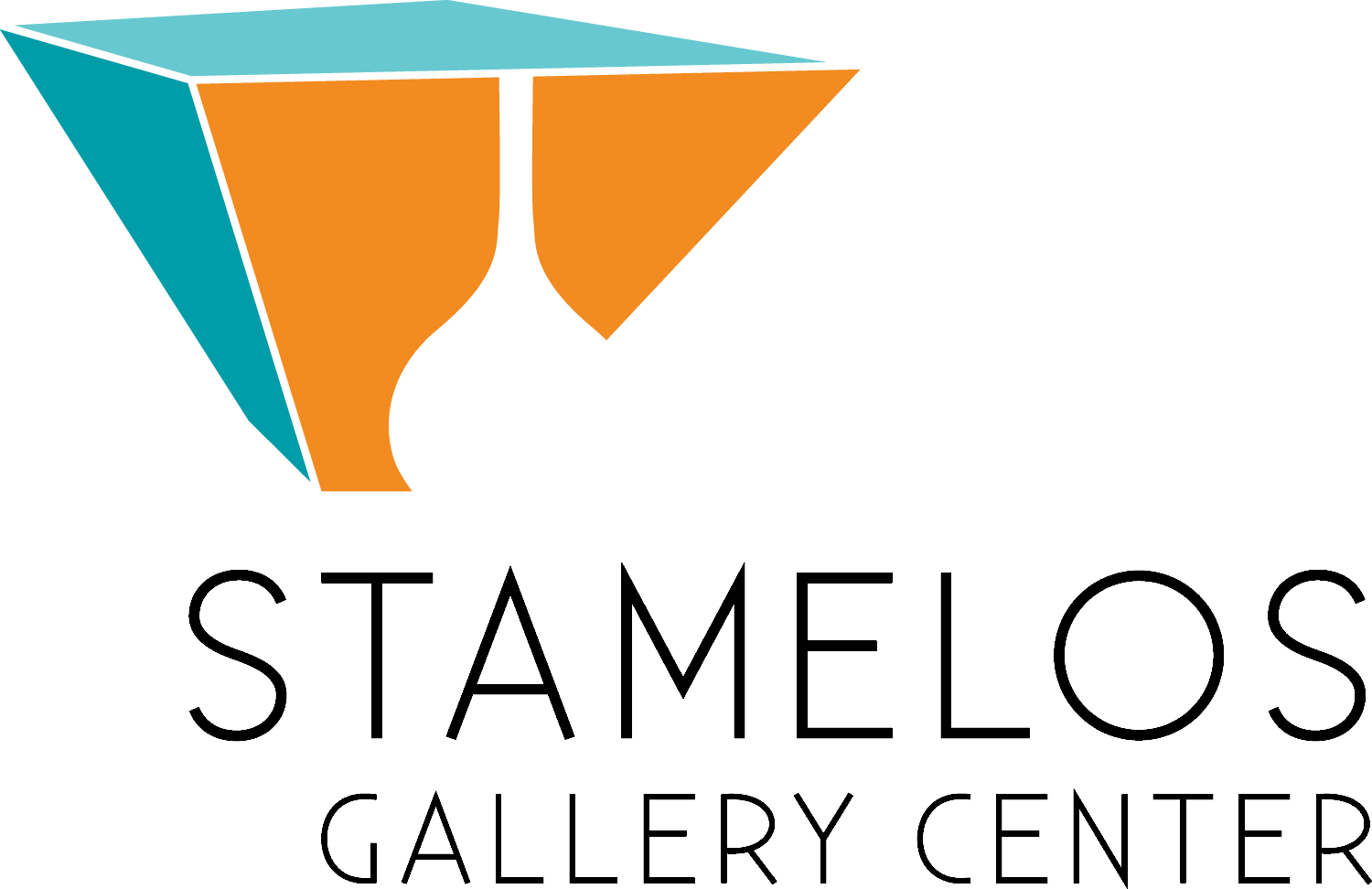
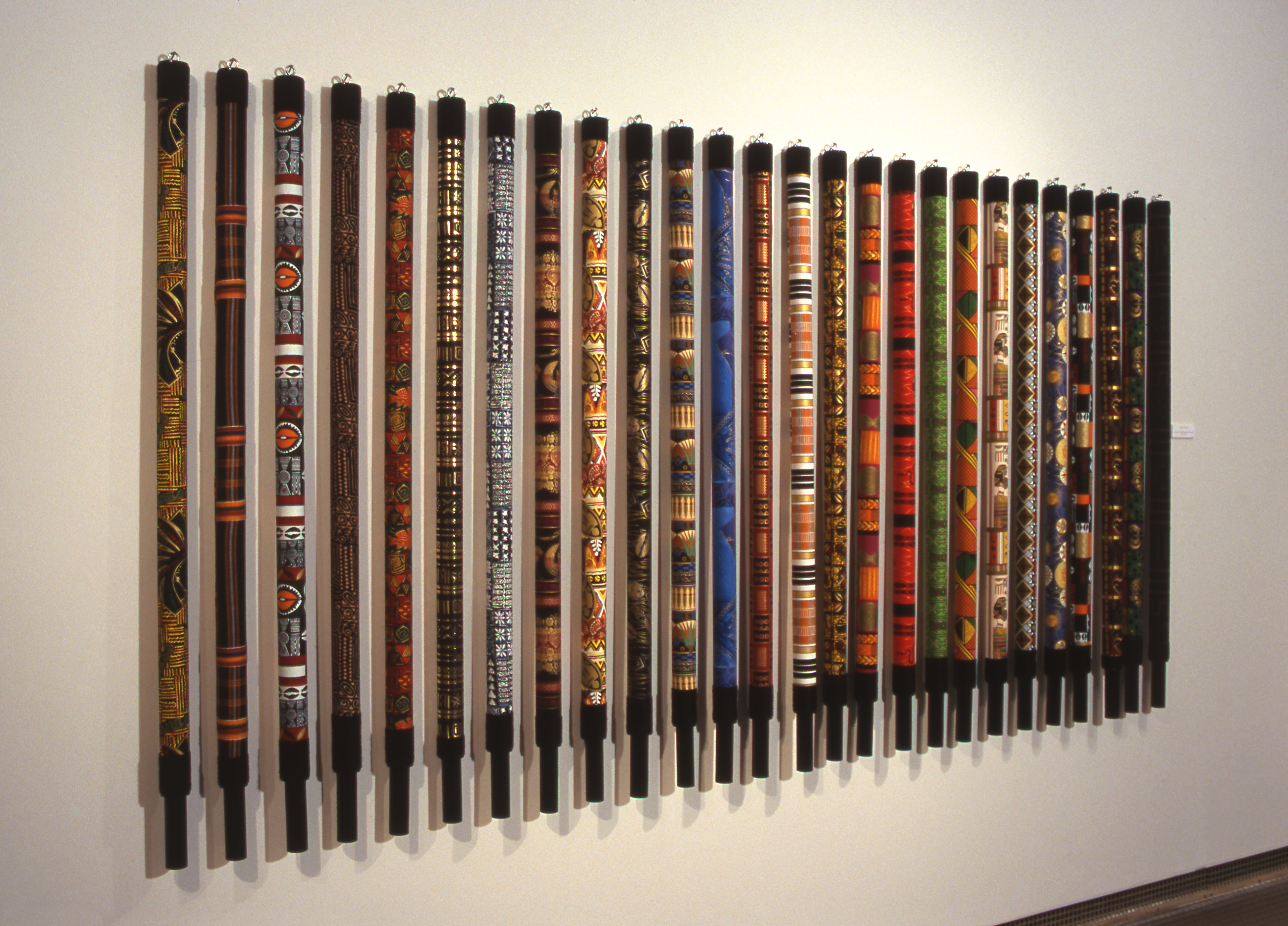
A Garland of Praise Songs for Rosa Parks, Lester Johnson
Wayne State University Art Collection
This boldly colored sculpture made of 26 wood, fiber and fabric totems embodies the American struggle for social justice. This striking piece has been permanently displayed at Wayne State University Law School’s Damon J. Keith Center for Civil Rights in Detroit since 2014.
Through much of his work, Johnson highlights the universal nature of fibers and cloth and its direct correlation with humanity, reminding viewers of their interconnectedness. Cloth has the ability to unite, but also to differentiate one cultural or ethnic group from another, as the distinctive colors, designs, and types of fabric selected by each community represent their heritage, traditions, and history.
Marlene's Gift, Lester Johnson
The inspiration for this artwork is to praise the collective lives and accomplishments of Rosa Parks and Judge Damon J. Keith. The work is a tribute to their extraordinary integrity and courage.
Rosa Park's skill as a seamstress unites her with artists worldwide who share a love for the tradition of creating handmade garments and quilts. Each totem has a wooden base enhanced with fabric inspired by traditional Australian Aboriginal patterns and African staffs. The hearts, hands, and minds of several area artists collaborated to ensure that this project, honoring two noteworthy patriotic Americans, would be successful. The Rosa Parks historical legacy is an American story.
The rich fabric is significant. It represents traditional African cloth worn by Africans and those of African descent. It embodies community, uniting the fabric makers, the art itself and the viewers. It honors Parks’ vocation as a seamstress. And it highlights the brilliance of creation: Just as a seamstress builds bolts of cloth from threads, Black Americans have created community, livelihoods and spirituality despite exclusion and injustice.
Judge Keith, a revered Detroit civil rights icon and the longest serving Black American judge in the nation, exemplifies how the Black community has interwoven intelligence, bravery and tenacity to achieve greatness despite the odds. The fabric also illuminates the kinship between art and the civil rights movement, inviting us to contemplate the imagery, objects and narratives of social justice that exist outside courtrooms.
— Lester Johnson
Gladys Knight’s lifetime achievements are noteworthy. Her lifelong successful career is a beacon of light for aspiring young people who can emulate her pathway. Knight’s exquisite musical voice comes from a place grounded in faith and integrity. The world community benefits from her dedication and commitment to excellence. “One for Gladys Knight” honors this extraordinary artist whose enduring spirit continues to engender love for humanity with her music.
— Lester Johnson
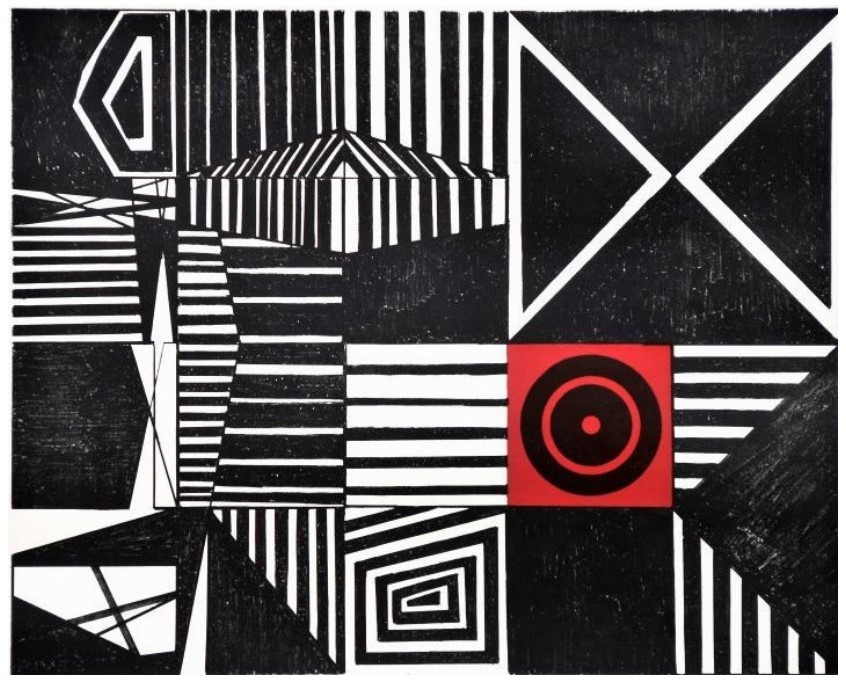
One for Gladys Knight, Lester Johnson
University of Michigan Museum of Art, Gift of Detroit Workshop of Fine Prints, 1975/1.58
Lynn's Song, Lester Johnson
A Love Supreme John Coltrane Tribute, Lester Johnson
The expansion to three-dimensional abstraction in my work was inspired by several artists including Al Loving who worked with Lynn Forgach, Director, Exeter Press & Paper in New York City. Loving had a great enthusiasm for the process of papermaking and rightfully predicted Forgach’s expertise as a collaborative artist. In 1983 I traveled to New York City seeking an introduction to the concept of exploring paper methods as a newcomer to the process.
I simply wanted my artwork made with paper to reflect my continuing fascination with primal cultures from both Africa and Australia. I look at papermaking as a challenge and an opportunity to explore a wide range of questions that include my long-standing interest in the use of natural materials. Paper pulp, made of 100% cotton fiber and dyed with various colors, allowed me to pursue themes and forms of expression initiated in earlier totemic work.
Working with Forgach and her staff, which included students with apprenticeship positions, at Exeter Press expanded my technical skills and thus enhanced the direction of my work. That gateway provided both a new horizon and a challenge that continues today, and this fresh approach can be seen in “Lynn's Song, 1984-1985,” and “A Love Supreme John Coltrane Tribute, 2003.” Loving and Forgach shared with me their creative intellect and collective wisdom that has elevated my work. My collaboration with them is everlasting and their spirit radiates.
— Lester Johnson
Claudia’s Choice is an example of Johnson’s collaborative work. He has often pondered how his art has been made and informed. The artist believes that his work is not just his journey, but a collective journey with others. His collaborations often occur with people outside of the art field.
Johnson’s friend Claudia traveled to Kenya, Africa, and while shopping at a local market or store, she purchased a woven patterned fabric. Its unique earth tones reference Kenyan heritage, and the artist found it to be relevant for inclusion into his current work. Johnson is grateful for Claudia’s thoughtful contribution to his fabric collection. He believes this type of universal cloth reflects a shared appreciation by world cultures for the arts.
Claudia's Choice, Lester Johnson
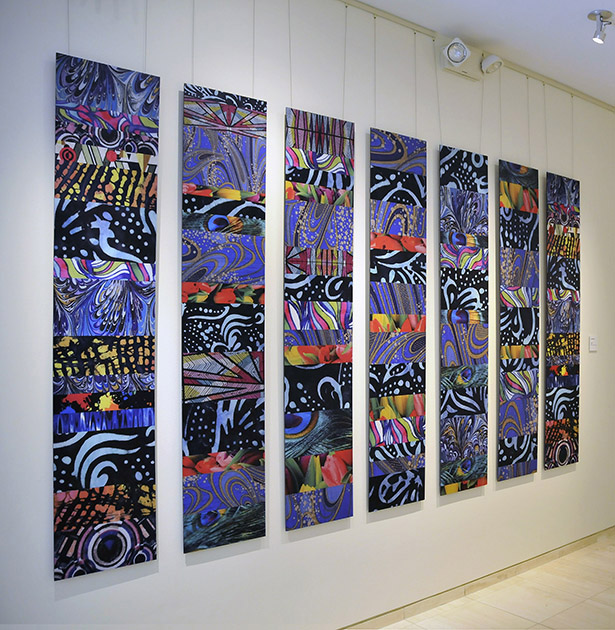
Jubilation, Lester Johnson
Celebration, Lester Johnson
Jubilation was inspired by the Randall poem below:
Your art is seeds
Growing to flowers and trees
Which will themselves bear seeds
To propagate new art, a giving
And a receiving intertwined through time.
— Dudley Randall- Poet Laureate, City of Detroit
Johnson’s African- Kimono series of sculptures and cast paperworks were inspired by Australian Aboriginal Peoples, African Primal Cultures, and the Japanese Kimono as well as influential figures like Miriam Makeba and Nelson Mandela. The process began with sketchbook drawings and then the paperworks which contain elements of collage, mixed media assemblage, and binding.
The artist then created a series of maquettes before collaborating on the final sculptural works with Kevin Davidson, Director of Design and Fabrication Services at the Charles H. Wright Museum of African American History and seamstress Wonner Lawson. They worked together to incorporate rich elements like korhogo heritage cloth from the Ivory Coast. The Senufo people have traditionally made korhogo by hand painting designs on hand woven and hand spun cotton fabric. The paintings are created using a specially fermented mud-based and natural vegetal pigment that darkens over time, and the cloth is decorated with symbols of humans, and natural elements like the sun, moon, stars and animals.
Miriam Makeba Tribute, Lester Johnson
Nelson Mandela, Lester Johnson
The artist would like to express his gratitude to Kevin Davidson, Director, Design and Fabrication Service, Charles H. Wright Museum; Grace Serra, Director of Wayne State University Art Collection; Peter Hammer, Director of the Damon J. Keith Center for Civil Rights, Wayne State University; Laura Cotton, Art Curator and Gallery Manager, Autumn Muir, Registrar, and Brooke Palomba, Gallery Intern, Stamelos Gallery Center, University of Michigan – Dearborn.
The Stamelos Gallery Center and the artist would like to thank the Flint Institute of Arts, the University of Michigan Museum of Art, and Wayne State University for generously loaning artwork to this exhibition.
The Stamelos Gallery Center is located on the first floor of the Mardigian Library at the University of Michigan-Dearborn. For more information, see below for contact information. Anyone requiring accommodations under the provisions of the Americans with Disabilities Act should contact lacotton@umich.edu.
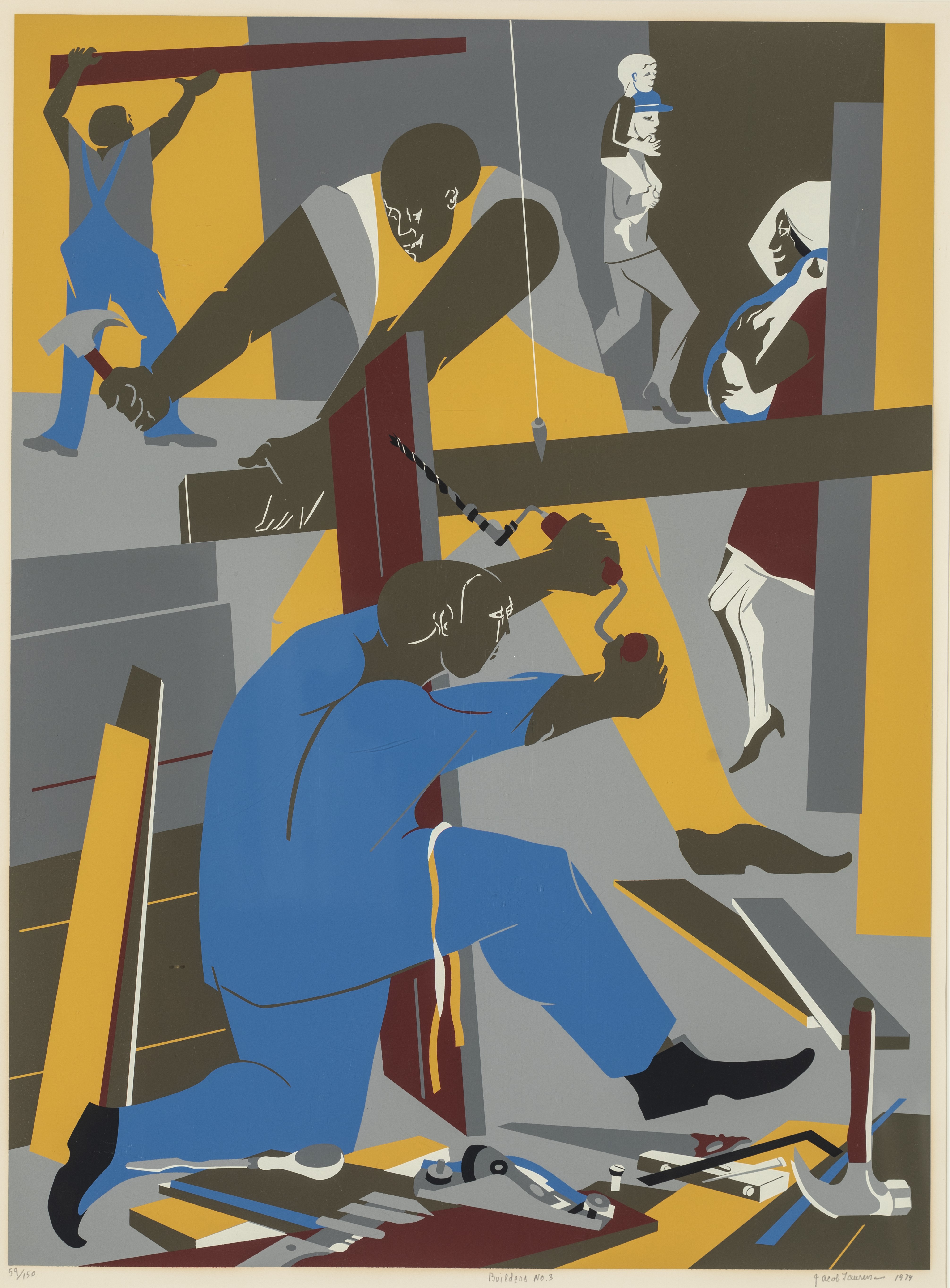
Jacob Lawrence (1917-2000), Serigraph print, 1974
Gift of Gilbert M. Frimet,
Collection of UM-Dearborn (1980.065)
Photographed by Tim Thayer
This powerful serigraph print from the permanent collection was created by Jacob Lawrence (1917-2000), one of this century's most widely acclaimed artists.
Lawrence was born in Atlantic City, New Jersey, but moved to Harlem, New York, at 13. He is among the few painters of his generation who grew up in a Black community, received instruction primarily from Black artists, and was influenced by the experiences of Black individuals.
Lawrence's artwork portrays the lives and struggles of the Black community, capturing their experiences through several series focused on figures such as Toussaint L'Ouverture, Frederick Douglass, and Harriet Tubman, as well as themes related to life in Harlem and the civil rights movement of the 1960s. His style is characterized by vibrant colors and abstract forms.
In the 1940s, during a time of widespread segregation, Lawrence broke racial barriers by becoming the first Black artist whose work was acquired by the Museum of Modern Art in New York City.
He stated, "If at times my productions do not express the conventionally beautiful, there is always an effort to express the universal beauty of man's continuous struggle to lift his social position and to add dimension to his spiritual being."
Researched and written by:
Julianna Collins, Stamelos Gallery Center former intern, UM-Dearborn art history/museum studies graduate, Class of 2025